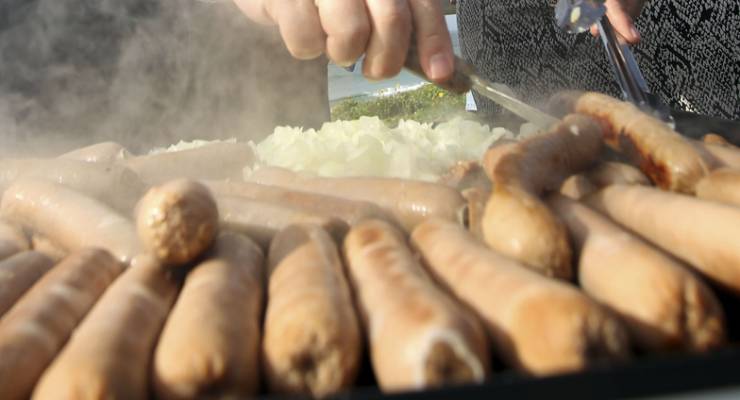
Not sure what you need to do on July 2 to fulfill your obligations as a citizen of Australia, or just hankering to know where to get the best feed as you do your democratic duty? We have you covered.
Where to vote
The AEC website can tell you where to vote near you, but frankly, that’s boring. If you’re voting on election day (something over 2 million of us aren’t doing because they voted early) then voting means one thing: Democracy Sausage.
If you want to know where the best selection of sausage sizzle (or tofu burgers if you live in an inner-city electorate) and cake stalls are, there are a few competing services. Democracy Sausage and SnagVotes are the two biggest. Twitter is also getting in on the action. You can tweet at @Auspolling with the hashtag #ausvotes and it’ll tell you where your nearest polling station is. You need to have geolocation services turned on for your tweet, which might not be the best, security-wise.
How to vote
Voting for the House of Representatives is the same. You can pick your choice as No. 1 and then number all the other boxes up to the end (the highest number of candidates running in any seat is 11). Under legislation passed just before the election was called, there’s a change to the way we vote in the Senate now.
For the white Senate ballot paper, voters must number at least six boxes above the line now. If you want to vote below the line, you used to have to fill out every single box (in Victoria this means 116 spots), but now all you need to do is number a minimum of 12.
Kenneth Tsang, who goes by Jxeeno on Twitter, has put together a very useful tool on Finder.com.au to help you decide your preferences. Once you’ve selected your state, you get a list of the parties and can group them sequentially from your highest preference to “no, that party should definitely not be elected”. After that it’ll give you a list of individual candidates so if there’s a party you want to rank high, but a candidate in that party you don’t particularly like, you can drop them down, and it’ll adjust your preferences accordingly.
It’ll also allow you to print it out in the order it would appear on the ballot paper, so you can take it into the polling booth and not get too confused numbering all the boxes.
Not too sure about the parties you’ll be voting for?
You’ve probably done the Vote Compass or its Fairfax counterpart to see where your politics sit with the big three parties, but if you’re not sure about some of the minor parties running in this election, our guide to the minors should be some help.
What to watch
Polls close at 6pm, and the endless night of media coverage starts soon after. Our friends at Daily Review have done a write-up of the options on television for the night. Leigh Sales is taking over the ABC captaincy for ABC coverage from Kerry O’Brien for the first time. Channel Seven has decided that the combination of Mark Latham and Jacqui Lambie would be fun, for some reason. Nine has Amanda Vanstone and Peter Costello. That could be fun if Kelly O’Dwyer loses Costello’s old seat.
Sky News has Alan Jones. And for some reason Paul Murray got the midnight shift between 12am and 2am. That should be … something.
The Crikey crew will be running a live blog across the night with our journalists keeping track of all the results from the Crikey bunker, and out at the election night parties for the Coalition in Sydney, Labor at the glamorous Moonee Valley Racing Club, and the Greens at the Forum in Melbourne.
William Bowe has a guide put together for the seats to watch, and there is a drinking game we have prepared if you’re looking for a big night.








You omit one viable voting option (because you’re frightened of discussing it?). And that’s to vote INFORMAL. An educated informal vote (in other words, as a deliberate strategy), might result in the commencement of a movement to change the way the total political/government process works in Australia.
If we continue to force ourselves to vote, as we have been the past 2 or 3 general and state elections, we’ll just continue to receive more of the same… only worse. Forget the ancient wisdom ‘you have to make your vote count’ (how do you do that when you have nought but contempt for all players in the game and no confidence in the processes?), or ‘your forefathers fought for this right’ (true, but irrelevant to our contemporary situation), or ‘there are people in other countries who would love to able to vote freely’ (true, but is the same glib advice as ‘clean up your plate, think of the starving millions in Biafra’).
Earnest exhortations to ‘get out and vote’ only increase the donkey vote (and how does that improve the overall outcome?) and only serve the established political elites. On the other hand, a dramatic national increase in the informal vote is likely to be a short-term phenomenon and would send an eloquent message to the captains of the political industry–and just as importantly–to a jaded electorate that is beginning to seek an alternative. Outdated arguments that expound the notion that voting is a national responsibility belong to an era now gone, when politicians were less-inclined to prostitute themselves in the pursuit of electoral success and when a less-corrupt political process still accorded us the option of applying a degree of sophistication to our exercise of choice.
An informal vote tomorrow (and again at the next election, if needs be) will hasten a fundamental change in this toxic and artificial process to which we have gravitated.